 Last night’s gala opening of Majestic 12 was a great success!
Last night’s gala opening of Majestic 12 was a great success!
More than 60 people came from as far as 100 miles away to attend the opening of our sixth annual showcase of student exhibitions, which is the product of American Studies 835, my Fall museum studies course.
The students installed a sample of their items in one case (each) in the reading room, which will remain up until June 30, 2017. Their full exhibitions are online as well, and links to all of the shows are HERE.
And here is a fuller album of photos on Flickr.
Copies of the booklet we published are available–please e-mail the Head Curator.
Many thanks to the students for all of their hard work this semester!
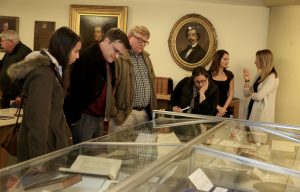


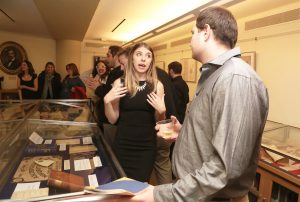


Comments Off on Majestic 12!
[Posted by Jennifer Sharp M’11, a Project Archivist with the Watkinson Library]
 One of the pieces in the Charles P. Wells collection that I enjoyed finding is a copybook, owned by Susanna Olmsted. The poem, written by Esther Lewis, seems to have been written out by Susanna’s friend, E.Benton, presumably prior to Susanna’s marriage.
One of the pieces in the Charles P. Wells collection that I enjoyed finding is a copybook, owned by Susanna Olmsted. The poem, written by Esther Lewis, seems to have been written out by Susanna’s friend, E.Benton, presumably prior to Susanna’s marriage.
The first page reads:
Advice to a Lady lately Married
Dear Peggy since the single State / You’ve left & chose yourself a Mate / Since metamorphos’d to a Wife / And Bliss or Woe’s insur’d for Life
A friendly Muse the way would show / To gain the Bliss & miss the Woe. / But first of all I must suppose / You,ve with mature reflection chose /
And this premis’d I think you may / Here find to married Bliss the way. / Small is the province of a Wife / And narrow is her Sphere in Life /
Within that Sphere to move aright / Should be her principal Delight. / To guide the House with prudent ease / And properly to spend & spare /
To make her Husband bless the Day / He gave his Liberty away.
 The final page is where we find out the book was owned by Susanna. I spent several hours trying to connect Susanna Olmsted with the Wells family, but wasn’t able to do so. I may keep trying! There were few enough families in Hartford when this was written (1775), that I’m sure we have a connection in a ‘Six Degrees of Kevin Bacon’ sort of way. This is my final post about the collection. I have arranged it all, and the finding aid is in progress. I hope you will visit the Watkinson and use the collection. Thank you for reading!
The final page is where we find out the book was owned by Susanna. I spent several hours trying to connect Susanna Olmsted with the Wells family, but wasn’t able to do so. I may keep trying! There were few enough families in Hartford when this was written (1775), that I’m sure we have a connection in a ‘Six Degrees of Kevin Bacon’ sort of way. This is my final post about the collection. I have arranged it all, and the finding aid is in progress. I hope you will visit the Watkinson and use the collection. Thank you for reading!
Comments Off on Miss Susanna Olmsted Her Book
[Posted by Ashley Esposito, a graduate student in American Studies doing an internship in the Watkinson]
 Leigh Couch Collection in progress…
Leigh Couch Collection in progress…
This week I was able to focus on The Magazine of Fantasy and Science Fiction. Beginning its publishing in October 1949, Fantasy, persists to this day in print. Yes, you read that correctly, F&SF is still printed on paper as a digest style magazine. You can subscribe for about $36.97 for 6 issues per year. Between Oct 1949 and Dec 2016, F&SF has published 723 volumes. Starting in 2010, F&SF converted its publishing schedule to bi-monthly with continued success and circulation.
The six-cover progression seen to the left shows the growth of the magazine over the years while it sought to define its brand, and the one below shows the 30th anniversary issue that lists on its cover the authors that are included in that 320-page edition.
At first the inventory of Fantasy and Science Fiction was so overwhelming. So many volumes. Over 450 volumes are in the collection between 1951 and 1994. It was truly amazing to see the progression of the covers, printing, binding and issue prices. As part of the inventory process a listing of all volumes held, original volumes held is compared to the total number of volumes originally issued. This process was a labor of love. I have truly found a worthwhile research opportunity with the Leigh Couch collection.
Comments Off on Magazine of Fantasy and Science Fiction
[Posted by Jennifer Sharp M’11, a Project Archivist with the Watkinson Library]
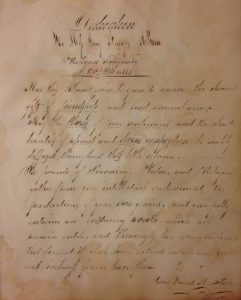 A common practice in the nineteenth century was to maintain a friendship album. Though mostly kept by women, entries were often from both men and women. The albums contained poems and stories, and served a purpose similar to a high school yearbook or a Facebook wall.
A common practice in the nineteenth century was to maintain a friendship album. Though mostly kept by women, entries were often from both men and women. The albums contained poems and stories, and served a purpose similar to a high school yearbook or a Facebook wall.
Lucy Strong was the sister of Charles Wells’ wife, Jane Naomi (Strong) Wells. As we can tell from the album’s dedication, in 1832 Lucy attended (or perhaps just visited) Wesleyan Academy, now Wilbraham & Monson Academy in Wilbraham, Massachusetts.
She received entries from several men there, including one from Columbia, South Carolina, and another from New Hartford, Connecticut.
While often the entries were just text, some, such as this entry from Clarissa Talmage, were far more intricate.
Though water damaged, the pages all remain legible. It’s great to have this example of a nineteenth century custom in the collection.
*I have learned from online histories of Wilbraham & Monson that Wesleyan Academy was the first co-ed boarding school in the country. The wording in the dedication makes it sound like Lucy was a student there, but in my quick search I was unable to find a date for co-education.

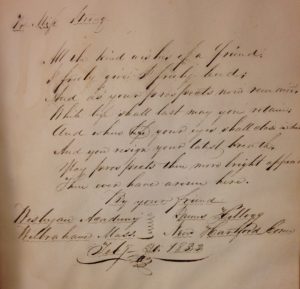

Comments Off on Friendship album
[Posted by Jennifer Sharp M’11, a Project Archivist with the Watkinson Library]
When Charles P. Wells died, it was reported in Hartford’s two prominent daily newspapers. The Hartford Daily Times described his character as “peculiarly self-contained and reserved.” Similarly, the Hartford Daily Courant wrote that “Partaking largely of the Quaker character of his father, he led a quiet, undemonstrative life, and in some sort the world went by him.”
Charles P. Wells’ collection, with its many pages of Bible study notes, does suggest that quiet study was a significant part of his day-to-day life. There are other pieces in the collection, though, that provide a glimpse of a more playful side.
 While in his early 20s, Wells entered into several “agreements” with friends. One, signed with his friend John Corning, was that neither man would go to Hartford’s Front Street for a month. Another was that Wells and a friend would not “associate with any young woman damsel or girl” for one year.
While in his early 20s, Wells entered into several “agreements” with friends. One, signed with his friend John Corning, was that neither man would go to Hartford’s Front Street for a month. Another was that Wells and a friend would not “associate with any young woman damsel or girl” for one year.
 By far, the most intricate of these was the Hebedatombobyboosthimout Club (no, I don’t know how you pronounce that). The initial club document I found is three handwritten pages, in small script, with little space between the lines. Additionally, there is a Book of Record. At the end of the first entry, written in pencil (in a different hand), is a list of the four members: Charles Stanton, L.H. Goodwin, Charles Wells, and John Corning.
By far, the most intricate of these was the Hebedatombobyboosthimout Club (no, I don’t know how you pronounce that). The initial club document I found is three handwritten pages, in small script, with little space between the lines. Additionally, there is a Book of Record. At the end of the first entry, written in pencil (in a different hand), is a list of the four members: Charles Stanton, L.H. Goodwin, Charles Wells, and John Corning.
The document and the record book are not easy reading. But they are certainly among the more unique items in the Wells collection. I encourage you to visit the Watkinson and take a look.



Comments Off on Juvenalia of Charles P. Wells
[Posted by Ashley Esposito, a graduate student in American Studies doing an internship in the Watkinson]
 Leigh Couch Collection in progress…
Leigh Couch Collection in progress…
This week my focus was on Analog Science Fiction. Originally published under the title Astounding Stories from 1937-1960 then making the transition to a few versions of Analog that juggled “science fiction,” “science fact” and even “science fiction & fact.” Analog published 664 volumes from 1960-2016. This collection includes volumes from 1960-1994. In the first picture you can see just how impressive that is. Our digital age has taken a toll on the tangible printed word so it makes this collection nostalgic.
The pictures show the progression from Astounding Stories to Analog and its further progressive reimagining. The progressively evolve from February 1960 and January 1961 you can see the stylized font associated with Astounding Stories (AS) continuing the visual character from its covers. On the top right cover from January 1963 you can see the title is Analog Science Fact Science Fiction complete with the symbol for that was created to the magazine to give the full title ‘ANALOG – Science Fact is analogous to Science Fiction’. In 1966 the symbol all but disappears from the cover at yet it persisted on the binding until about 1974 where it seems to disappear completely.
The cover font and layout went through a few versions until the 1990s when it settled on its current presentation. The last photo is of the recently published November 2016.
 I enjoyed getting to know Analog not only because it is such a long-standing publication that gives a different insight into society but also because I can see some of my favorite concepts and images from science fiction being born on the covers and in the pages of Analog.
I enjoyed getting to know Analog not only because it is such a long-standing publication that gives a different insight into society but also because I can see some of my favorite concepts and images from science fiction being born on the covers and in the pages of Analog.
Additional Resources:
www.sf-enyclopedia.com
www.isfdb.org
THIS JUST IN!
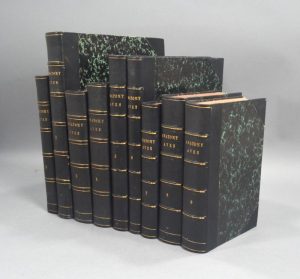 A collection of one hundred 18th and 19th century articles, offprints and monographs relating to bird anatomy in English, German, French, Dutch, Italian and Latin, and illustrated with 145 plates, mostly lithographs and engravings.
A collection of one hundred 18th and 19th century articles, offprints and monographs relating to bird anatomy in English, German, French, Dutch, Italian and Latin, and illustrated with 145 plates, mostly lithographs and engravings.
John Amory Jeffries (1859-1892) was one of the original active members of the American Ornithologists’ Union founded in 1883, but his interest in ornithology had developed much earlier. He and his brother, W. A. Jeffries, performed active field work which gave him, even before he entered Harvard College in 1877, “an unusually thorough knowledge of local ornithology as well as a very considerable collection of birds.” Although his love of field work continued, he turned his attention to anatomical and biological work while attending Harvard College (1877-1881) and, afterwards, Harvard Medical School (1881-1884). During those years he found time to do a surprising amount of anatomical and embryological work upon birds, giving his attention largely to the development of feathers and other epidermal structures. After receiving his M.D., he went to Europe for two more years of study, mostly at Vienna and Berlin. He returned to Boston in 1886, establishing himself professionally and continuing his ornithological studies until his premature death from pneumonia at age 33.
Comments Off on Bird anatomy in multiple languages
Recently acquired!
 Autograph Letter from John James Audubon to Robert Havell, Jr., dated July 21, 1839.
Autograph Letter from John James Audubon to Robert Havell, Jr., dated July 21, 1839.
With instructions to deliver casks of natural history objects to Sheffield, and wishing him a pleasant voyage to America. Having spent 1837-39 in England, finalizing the publication of the Birds of America, Audubon writes to Havell days before both men depart for America: “…We will sail on Monday next . . . from this port for New York on board the packet ship the George Washington . . . You and Mrs. Havell and daughter will sail from London on the 1st of August . . .”
Upon their arrival, Havell and his family stayed with the Audubons in Brooklyn before moving to Ossining, NY, and subsequently to Tarryown, where he spent the remaining years of his life painting and engraving landscapes and views of the Hudson River and of American cities.
This is a nice addition to the collection, especially since our copy of Audubon’s Birds of America was Robert Havell’s own copy–it sold to a New York firm just after Havell died, and bought that same year by Dr. Gurdon Russell, Trinity Class of 1834, who gave it to the College in 1900.
Comments Off on Audubon letter
[Posted by Ashley Esposito, a graduate student in American Studies doing an internship in the Watkinson]
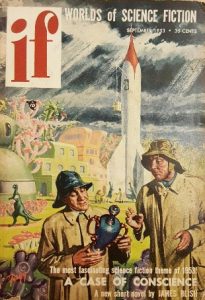 Leigh Couch Collection in progress…
Leigh Couch Collection in progress…
This week I spent time with the If Science Fiction magazine, also know as the Worlds of If. IF has 175 volumes published between March of 1952 and December of 1974. It was under the same publishing umbrella as Galaxy so it often shared authors, stories and advertisers. The Leigh Couch Collection has 130 volumes of the 175 printed.
Authors included Robert A Heinlein, Keith Laumer, James Blish, A E Van Vogt and Jacqueline Lichtenberg.
It has been suggested that both Galaxy and If did not get the recognition they deserved during the 1960s because of the sloppy printing and binding that is visible in both magazines. The content of the magazines was considered quality writing. By comparison, the 1970s volumes are much better designed and bound. When you factor in the change in cover price in the 1960s of .35 to .60 in 1970s it is easy to see where the additional funds came from to present the magazine in a better light.
I also noticed in IF that the normal mail order correspondence course and book order forms were replaced by full color advertising inserts for tobacco products. So it seems that If began to take departure from Galaxy.
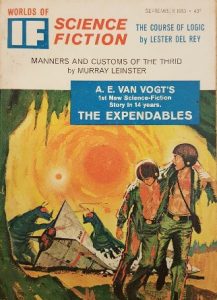 As I continue to explore this collection, I am overwhelmed by the diverse research potential and interest that exists within its pages.
As I continue to explore this collection, I am overwhelmed by the diverse research potential and interest that exists within its pages.
Resources:
www.sf-enyclopedia.com
www.isfdb.org
Comments Off on Worlds of IF
 Linh Tran’17 was born in Russia, raised in Vietnam and came to the U.S for an undergraduate degree at Trinity College. She is an Economics major with a deep interest in the financial services and real estate industries. Having recently completed her spring semester in Denmark, where she was a student blogger, she explored her arts interest at Trinity as the President of Ballroom Dance Team and the contributing photographer of Humans of Trinity. Linh’s proposal is to learn about classic pottery patterns, especially on the works of Josiah Wedgewood. Inspired by Trinity and Trinity’s history, Linh intends to incorporate an image of the school’s Chapel, the year it was built and Trinity’s logo into the patterns that she will draw on pottery. She intends to show the harmonious combination of classic and modern patterns and also wants to donate to Trinity the potteries that represent the school’s spirit.
Linh Tran’17 was born in Russia, raised in Vietnam and came to the U.S for an undergraduate degree at Trinity College. She is an Economics major with a deep interest in the financial services and real estate industries. Having recently completed her spring semester in Denmark, where she was a student blogger, she explored her arts interest at Trinity as the President of Ballroom Dance Team and the contributing photographer of Humans of Trinity. Linh’s proposal is to learn about classic pottery patterns, especially on the works of Josiah Wedgewood. Inspired by Trinity and Trinity’s history, Linh intends to incorporate an image of the school’s Chapel, the year it was built and Trinity’s logo into the patterns that she will draw on pottery. She intends to show the harmonious combination of classic and modern patterns and also wants to donate to Trinity the potteries that represent the school’s spirit.
 Charles Meier McMahon ’18 of West Hartford, CT, has always been fascinated by the perceived dichotomy between western and eastern civilizations. Throughout the course of this semester, he will be encountering texts that relate to this theme, from analyzing a religious manuscript to reading travel narratives, and also looking at the materials that went into producing them. He will keep a blog of his observations, and by the end of the semester intends to produce an illustrated pamphlet.
Charles Meier McMahon ’18 of West Hartford, CT, has always been fascinated by the perceived dichotomy between western and eastern civilizations. Throughout the course of this semester, he will be encountering texts that relate to this theme, from analyzing a religious manuscript to reading travel narratives, and also looking at the materials that went into producing them. He will keep a blog of his observations, and by the end of the semester intends to produce an illustrated pamphlet.

Andrew Biedermann, ’18 is an art history major currently in his junior year. He hopes to attend graduate school in art history and one day enter the art world. Andrew’s interests in art are broad but he has been drawn for some time to museums and the profession of curating. Last year he curated a student art exhibition in Trinity’s Career Development Center, selecting 50 of the roughly 100 art submissions. This semester Andrew is delving into the Enders Collection of ornithological books. He expects to compile an illustrated catalogue of books pertaining to bird hunting. While Andrew does aspire to one day begin hunting, his main interest in the topic stems from the stunning prints he has encountered.
 Olivia Gibson ’17 is a International Studies, Religion, and Classics triple major at Trinity. She is also the president of the art collective on campus (The Mill) as well as Station Manager of the college radio station. Having been born in the heart of Silicon Valley and then raised in the old world surroundings of St. Andrews, Scotland, Olivia has always had a keen love of the interplay of past and present. Her proposal, motivated by her passions for history and art, is to use photos from the archives as well as her own observations to create a series of images which look at the history of student life at Trinity College, imagining how different scenes and organizations have changed over time and how different time periods can be layered over each other.
Olivia Gibson ’17 is a International Studies, Religion, and Classics triple major at Trinity. She is also the president of the art collective on campus (The Mill) as well as Station Manager of the college radio station. Having been born in the heart of Silicon Valley and then raised in the old world surroundings of St. Andrews, Scotland, Olivia has always had a keen love of the interplay of past and present. Her proposal, motivated by her passions for history and art, is to use photos from the archives as well as her own observations to create a series of images which look at the history of student life at Trinity College, imagining how different scenes and organizations have changed over time and how different time periods can be layered over each other.
Comments Off on Fall 2016 Creative Fellows
 One of the pieces in the Charles P. Wells collection that I enjoyed finding is a copybook, owned by Susanna Olmsted. The poem, written by Esther Lewis, seems to have been written out by Susanna’s friend, E.Benton, presumably prior to Susanna’s marriage.
One of the pieces in the Charles P. Wells collection that I enjoyed finding is a copybook, owned by Susanna Olmsted. The poem, written by Esther Lewis, seems to have been written out by Susanna’s friend, E.Benton, presumably prior to Susanna’s marriage. The final page is where we find out the book was owned by Susanna. I spent several hours trying to connect Susanna Olmsted with the Wells family, but wasn’t able to do so. I may keep trying! There were few enough families in Hartford when this was written (1775), that I’m sure we have a connection in a ‘Six Degrees of Kevin Bacon’ sort of way. This is my final post about the collection. I have arranged it all, and the finding aid is in progress. I hope you will visit the Watkinson and use the collection. Thank you for reading!
The final page is where we find out the book was owned by Susanna. I spent several hours trying to connect Susanna Olmsted with the Wells family, but wasn’t able to do so. I may keep trying! There were few enough families in Hartford when this was written (1775), that I’m sure we have a connection in a ‘Six Degrees of Kevin Bacon’ sort of way. This is my final post about the collection. I have arranged it all, and the finding aid is in progress. I hope you will visit the Watkinson and use the collection. Thank you for reading!



























